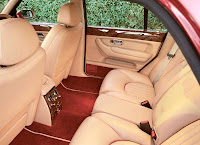Aston Martin DB Mark III, 1957
Aston Martin DB Mark III was launched at the Geneva Show in March 1957 and was available only for export until it was shown at the London Motor Show in October that same year. Aston Martin DB Mark III was the final development of the cars based on Claude Hill's chassis and the Lagonda six-cylinder twin overhead camshaft engine. It remained in production for circa nine months after the Aston Martin DB4 was introduced. Some 310 cars were exported to the USA.
Tadek Marek had finely re-designed the 3-litre engine. The standard DBA version of this engine had a stiffer crankshaft, a new block, oil pump and timing chain, new exhaust and induction manifolds, the ports were based on the Aston Martin DB3S engine, larger valves, high lift camshafts (after the first 150). With the same capacity (2,922cc) twin SU carburettors and compression ratio (8:16:1) as the VB6J engine, the improved breathing provided an output claimed to be 162 bhp at 5,500rpm.
The main change in the appearance of the car was the adoption of the elegant shape of the radiator opening from that of the DB3S and the consequent compound curves of the front of the bonnet, which can be traced on all subsequent models, including the V8. Inside, the main difference was a completely different facia and instrument panel (which remained in use until the Aston Martin DB6 Mark II was dropped in 1970). In 1959, for the first time, automatic transmission (Borg Warner) was offered (as an extra) for a production Aston Martin; it was installed only in four drophead coupes and one saloon.
Technical Specifications
* Engine: dohc I-6, 2922 cc, 162 bhp @ 5500 rpm
* Transmission: 4-speed manual
* Length: 14' 3.5" (435.5cm)
* Width 5'5" (165cm)
* Height 4' 6.25" (138cm)
* Wheelbase 8' 3" (251.5cm)
* Weight: 1,270 kg (2,800 lb)
* 0-60mph: 8.2 secs
Tadek Marek had finely re-designed the 3-litre engine. The standard DBA version of this engine had a stiffer crankshaft, a new block, oil pump and timing chain, new exhaust and induction manifolds, the ports were based on the Aston Martin DB3S engine, larger valves, high lift camshafts (after the first 150). With the same capacity (2,922cc) twin SU carburettors and compression ratio (8:16:1) as the VB6J engine, the improved breathing provided an output claimed to be 162 bhp at 5,500rpm.
The main change in the appearance of the car was the adoption of the elegant shape of the radiator opening from that of the DB3S and the consequent compound curves of the front of the bonnet, which can be traced on all subsequent models, including the V8. Inside, the main difference was a completely different facia and instrument panel (which remained in use until the Aston Martin DB6 Mark II was dropped in 1970). In 1959, for the first time, automatic transmission (Borg Warner) was offered (as an extra) for a production Aston Martin; it was installed only in four drophead coupes and one saloon.
Technical Specifications
* Engine: dohc I-6, 2922 cc, 162 bhp @ 5500 rpm
* Transmission: 4-speed manual
* Length: 14' 3.5" (435.5cm)
* Width 5'5" (165cm)
* Height 4' 6.25" (138cm)
* Wheelbase 8' 3" (251.5cm)
* Weight: 1,270 kg (2,800 lb)
* 0-60mph: 8.2 secs







